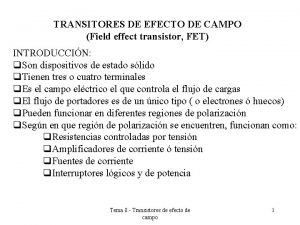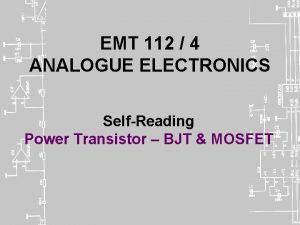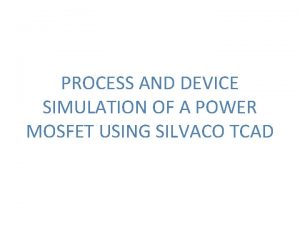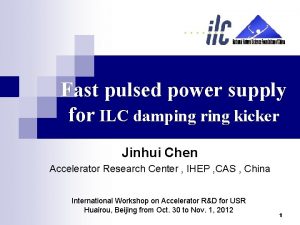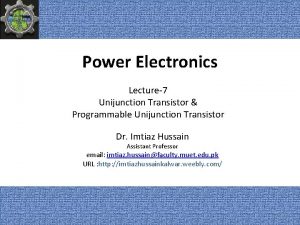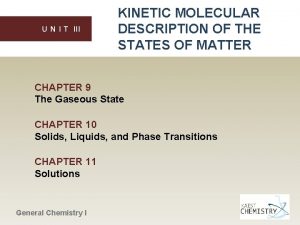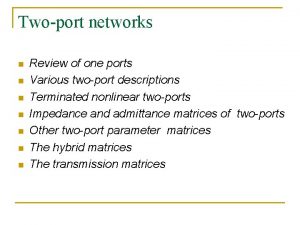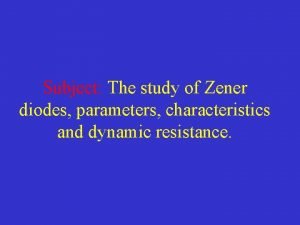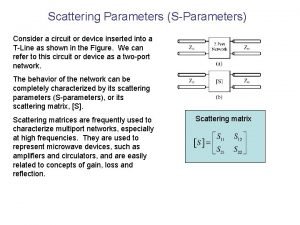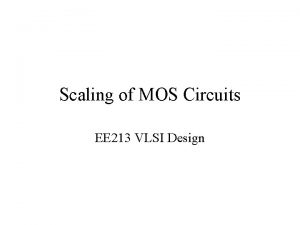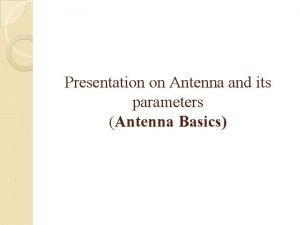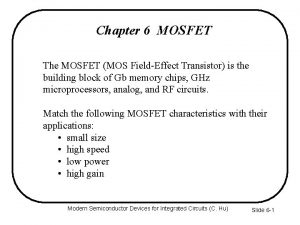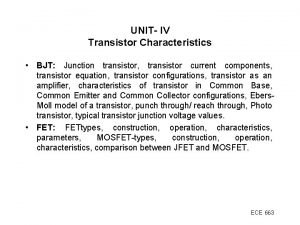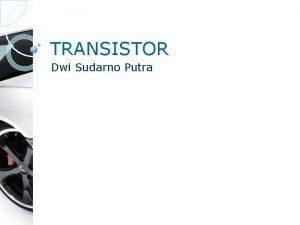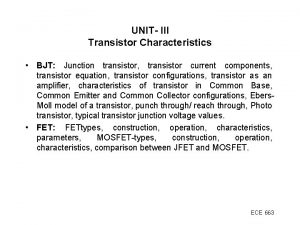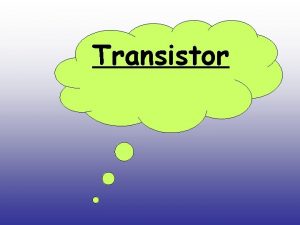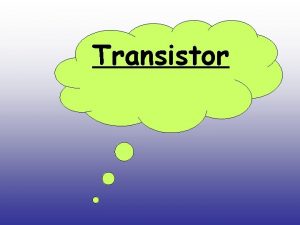POWER TRANSISTOR MOSFET Example of power MOSFET parameters




















- Slides: 20

POWER TRANSISTOR – MOSFET Example of power MOSFET parameters; Parameter VDS(max) (V) ID(max) (A) - @ T = 25 C PD (W) 2 N 675 7 150 2 N 679 2 400 8 2 75 20

POWER TRANSISTOR – MOSFET The superior characteristics of MOSFETs are; • Faster switching time; • No second breakdown; • Stable gain and response time over a wide temperature range (Figure on the next slide).

POWER TRANSISTOR Transconductance versus drain current curves for various values of temperature – less than the variation in BJT current gain. – MOSFET

POWER TRANSISTOR Transfer characteristics curves for various values of temperature. – MOSFET

POWER TRANSISTOR Structure – MOSFET

POWER TRANSISTOR Structure DMOS process can be used to produce a large number of hexagonal cells on a single chip. – MOSFET

POWER TRANSISTOR Structure These hexagonal cells can be paralleled to form large-area devices without the need of emitter ballast resistance. A single power MOSFET may contain as many as 25, 000 parallel cells. – MOSFET

POWER TRANSISTOR The “ON” resistive path between drain and source (rds(on)) is an important parameter in power capability of MOSFET – MOSFET

POWER TRANSISTOR BJT – Comparison MOSFET Requires complex input circuitry because of high input current (currentcontrolled device) Simple input circuitry because of low input current (voltage-controlled device). More sensitive to temperature variation – thermal runaway and problem of second breakdown. More immune to thermal runaway and second breakdown.

POWER TRANSISTOR – Heat sinks • The power dissipated in a transistor can cause an internal temperature rise above ambient temperature. • This heat, if not properly removed, may cause internal temperature above a safe limit and can cause permanent damage to transistor. • Heat may be removed through proper packaging:

POWER TRANSISTOR – Heat sinks • Additionally, heat sinks can be used to remove the heat developed in the transistor:

POWER TRANSISTOR Heat sinks (Extra) Temperature of transistor junction Ambient temperature Temperature difference Voltage difference Electrical equivalent circuit of thermalconduction process Thermal resistance between the junction and ambient Electrical resistance Thermal power through the element Electric current.

POWER TRANSISTOR Manufacturers’ data sheet for power devices generally give: • maximum operating junction (device) temperature, TJmax; • thermal resistance from the junction to the case, JC; The temperature conduction process may be represented as follows: Heat sinks (Extra)

POWER TRANSISTOR The following equation can be used to describe the temperature conduction process: If the heat sink is not used, then; Heat sinks (Extra)

POWER TRANSISTOR Heat sinks (Extra) EXAMPLE 8. 3 A MOSFET has the following parameters; Determine the maximum power dissipation in the transistor and determine the temperature of the transistor case and heat sink.

POWER TRANSISTOR EXAMPLE 8. 3 – Solution Maximum power (without heat sink) Maximum power (with heat sink) Heat sinks (Extra)

POWER TRANSISTOR Heat sinks (Extra) EXAMPLE 8. 3 – Solution (cont’d) Heat sink temperature

POWER TRANSISTOR Heat sinks (Extra) EXAMPLE 8. 3 – Solution (cont’d) Case temperature Note: The use of heat sink allows more power to be dissipated in the device.

POWER TRANSISTOR Heat sinks (Extra) Power derating curve Manufacturer usually specifies: • the maximum temperature TJmax; • the maximum power dissipation PDmax, at a particular ambient temperature TA 0 (usually 25 C); and • thermal resistance JA. In addition, a graph – power derating curve is provided.

POWER TRANSISTOR Heat sinks (Extra) Power derating curve For operation below TA 0, the device can safely dissipate the rated value of PD 0 watts. If the device is to be operated at higher ambient temperature, the maximum allowable power dissipation must be derated according to the straight line.
 Simbol komponen fet
Simbol komponen fet Deplexión
Deplexión Transistor power dissipation
Transistor power dissipation Application of power mosfet
Application of power mosfet Disipasi daya
Disipasi daya Power mosfet
Power mosfet Power triangle formula
Power triangle formula Define programmable unijunction transistor
Define programmable unijunction transistor 1/gm mosfet
1/gm mosfet Xcopy parameters
Xcopy parameters Lesson 4 parameters and return make
Lesson 4 parameters and return make Lesson 3 parameters and return practice
Lesson 3 parameters and return practice Lennard-jones parameters table
Lennard-jones parameters table Y parameter
Y parameter Asl parameter chart
Asl parameter chart Zener diode parameters
Zener diode parameters Sparameters
Sparameters Scaling factor in vlsi
Scaling factor in vlsi Satellite link design
Satellite link design Imperative language
Imperative language Basic antenna parameters
Basic antenna parameters

